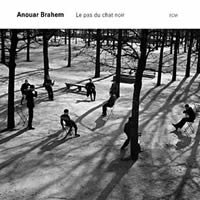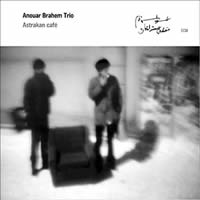Random Noise 1: Anouar Brahem on ECM
|
[This is the first of the Random Noise columns I have been writing for onsoundandmusic.com. Heartfelt gratitude to my OS&M editor for permission to post this and subsequent Random Noises in La Folia. M.S.] Mike Silverton [October 2003.] My thanks to Joel Flegler, Fanfare’s publisher, for permission to recycle. More years ago than I care to think about, I contributed a column entitled Random Noise to that fine bi-monthly. The title’s resurrection reveals a largely futile desire to nibble at one’s salad days. So hello, gentle reader, great to be with you. May wisdom and prosperity descend on us both — and of course our families and those we like and maybe even don’t. I propose to inaugurate my stint in OS&M’s cyberspatial niche by discussing several abundantly accessible CDs featuring a brilliant oud player, Anouar Brahem. A word first about ECM, the German-based label that brings us these honeyed treats. ECM’s main man-producer, Manfred Eicher, steers with a determined hand. I’m indebted to his enterprise for a striking revelation: a 1993 release, Heinz Holliger’s Scardanelli-Zyklus (Scardanelli Cycle) for flute, small orchestra and mixed chorus, ECM New Series 437 441-2. If you recognize Holliger’s name, it’s probably as a celebrated oboist with a huge discography to his credit. Scardanelli Cycle, which I hesitate to recommend to the casual listener, established his position, for me at least, as an important composer. As to my reluctance to pitch this set, when people ask me what I do, I tell them that I write about music nobody wants to listen to. Scardanelli Cycle, while dwelling for most of its duration in magically eerie understatement, would likely prove tough going for those unfamiliar with, or indifferent to, Europe’s classical avant-garde. (In our own period, the — drumroll, please — postmodern, the avant-garde’s astringencies, which developed a full head of steam in the years following WW2, are viewed as passé, or worse, elitist. Modernist idioms have taken a back seat to machine-shop simplistics and Romantic revivals — discussions for another time. As to Scardanelli, it’s one of the names the German Romantic poet Heinrich Hölderlin adopted during his long confinement as a lunatic.) If you’re up for an adventure, give it a shot. ECM keeps its catalog viable, which is more than can be said for a lot of labels. Again on the classical side, we’ve ECM’s rather more approachable Arvo Pärt releases, the first of which appeared, I believe, in 1984 — on silver, that is; the label’s inception and its interest in Pärt predate the compact disc.
I’ve not been an unqualified admirer. ECM has issued a great many jazz releases, in the main soft-edged and sweet. Not my cup of balm. I’ve also had difficulties with Eicher’s preference for an excessively reverberant acoustic, some of which sounds to me electronically enhanced. And then one day not long ago the label’s American publicist (and a gracious lady she is) sent a captivating release consistent with Eicher’s tastes. Le pas du chat noir features Anouar Brahem’s oud (a Middle-Eastern lute) with two French instrumentalists: François Couturier, piano, and Jean-Louis Matinier, accordion. If you’re into labeling hybrids, Franco-Levantine will do as well as any, though Brahem is Tunisian by birth — a tad beyond the Levant’s acreage. It’s the spirit that counts, and there’s plenty of that, much of it as vapor and mists. Ear-appeal: an imponderable subject onto which I’ll shed little light. I’ve already mentioned that I write about unpopular music. My wife and I, late of Brooklyn, resettled in a small town on Maine’s Midcoast. We’ve had a few guests to dinner in our new old house. Desert and coffee out of the way, milady likes to herd these gatherings into the front parlor (my listening room), where she likewise proposes that I play a CD. It’s an unnerving request — something I long ago learned to avoid as an exercise in frustration. I keep only those discs that interest me. Little of the collection is fit company for company, particularly as and adjunct to after-dinner conversation. But then one night, a guest not only adored what she heard but actually went out and bought the discs. Mirabile dictu! Nor was she the last to fall prey. Brahem hath charms, and they appear to stem from a seemingly inexhaustible fund of wistful melodies, mellow to mellower moods, housebroken exotics and, best of all, an impressive set of chops. Brahem’s ECM releases in the order of their issuance: Barzakh, ECM 1432, 1991. Brahem, oud; Bechir Selmi, violin; Lassad Hosni, percussion. That’s how it’s listed on the traycard: “Percussion.” Hosni performs here and elsewhere on the darbouka, a clay, goblet-shaped drum capped with a fish-skin, and the deeper-voiced bendir, a frame-drum. Conte de l’incroyable amour, ECM 1457, 1992. Brahem, oud; Barbaros Erköse, clarinet; Kudsi Erguner, nai; Lassad Hosni, bendir and darbouka. The nai is the Arab version of the ney, an end-blown reed flute, its habitat ranging from Morocco to Pakistan, and in sound somewhat reminiscent of the Japanese shakuhachi. A charmer. Madar, ECM 1515, 1994. Saxophonist Jan Garbarek, an ECM artist with his own hefty discography, takes top billing. We’ve Brahem of course and Ustad Shaukat Hussain on tabla. Talk about globalism! — the Belgian-born Adolphe Sax’s reed innovation, the Middle-Eastern oud and the Indian tabla, a double-drum, fraternizing with nary a care. Khomsa, ECM 1561, 1995. Brahem, oud; Richard Gálliano, accordion; François Couturier, piano, synthesizer; Jean Marc Larché, soprano saxophone; Béchir Selmi, violin; Palle Danielsson, double bass; Jon Christensen, drums. Thimar, ECM 1641, 1998. Brahem, oud; John Surman, soprano saxophone, bass clarinet; Dave Holland, double bass. Astrakan Café, ECM 1718, 2000. Here the ensemble is called the Anouar Brahem Trio, with Brahem, oud; Barbaros Erköse, clarinet; Lassad Hosni, bendir and darbouka. And, again, Le pas du chat noir, ECM 1792, 2002.
Astrakan Café is my runaway favorite, the emphasis on away, as in where spices waft on the air. (On the disc, café is given in the lower case, which, as an inspector emeritus of the Language Police, I perceive as a gaucherie I refuse to validate. Never mind that this is how the French do it.) I’ve mentioned Eicher’s preference for a wet acoustic. The venue for these 1999 sessions is an Austrian monastery, St. Gerold. You just know you’re hearing the real thing — air and space to die for. If I have that wrong, congratulations on a ravishing fraud. Sound Engineer Marcus Heiland must adore the place. I do violence to Paolo Scarneccia’s elegant notes (nicely translated from the Italian) by an abrupt summary: Brahem’s purpose, well out of the hackneyed mainstream, is a high-minded synthesis of Arabic and Moslem music. That Brahem is a rather amazing virtuoso is abundantly clear. No less captivating is the Egyptian Barbaros Erköse’s clarinet, which we hear often and to excellent effect. In the opening number, Aube rouge à Grozny, Erköse’s undulant lament does quite nicely as an erotically charged Dance of No Veils Whatever. In keeping with the music’s flavors, place names operate as titles and subtitles: In addition to Astrakan, a region in Central Asia, we’ve Azarbeidjan, Turkmenistan, Turkhestan, Tunis, Brahem’s cultural embrace stopping just short of Moslem Indonesia. The title tune, Astrakan Café, just perky enough in its amber-lit way to spark visions of the smoky, perhaps immaterial place it commemorates, is given twice, first as an impressive oud solo, latterly as a subtly insistent collaboration. Melodious, sensuous stuff luxuriantly paced, melancholy perhaps, thoughtful certainly, with playing of the highest order impeccably recorded. My wife likes it too. If you’re up for sampling a pair as a start, Le pas de chat noir would be my next choice, though it’s a pretty close call. Even my least favorite, Madar, wherein, like giraffes at a lawn party, Jan Garbarek’s soprano saxophones strive to integrate, has its enchantments. Khomsa, the other release I’d put low on the list, features a medley of Brahem’s music for Tunisian film and theater. In Thimar, John Surman’s soprano sax and bass clarinet wear their ethnic roles rather more gracefully. Brahem’s oud and the remarkable Dave Holland’s stringed bass in duet — one doesn’t get to hear many oud-bass duets — alone recommends purchase. The first release in this series, Barzahk, opens with “Raf Raf,” a fast-paced oud solo that in its extraordinary nimbleness would seem to declare, “I’m here!” Conte de l’incroyable amour’s title number is remarkably lovely in its sinuous, incense-scented way, as are the CD’s other 11 tracks. But oh, that manufactured spaciousness! — which, on reflection (sorry about that), has got to be a winner. The label’s been around for a very long time, and losers aren’t. For a thorough picture of ECM’s activities, go to http://www.ecmrecords.com/. * * * The sound system: Wilson WATT / Puppy 6 speakers Mark Levinson No. 390S CD player Mark Levinson No. 33H mono amplifiers RS Cables Palladium balanced interconnects Nordost Valhalla speaker cables Harmonix Reimyo ALS-777 line conditioner Harmonix Studio Master power cords Walker Audio Ultimate High Definition Links attached to the WATTs’ binding posts SRA VR series acoustic isolation platforms under player and amps SRA Tremor/Less acoustic isolation platform under the line conditioner Dedicated outlets for the electronics.
[More Mike Silverton, Random Noise]
[More
Brahem]
[Previous Article:
A Dernier CRI, Slices of Cantaloupe, and Schlag from Vienna Modern Masters]
[Next Article:
Mozart’s Rondo in A minor, K.V. 511]
|

